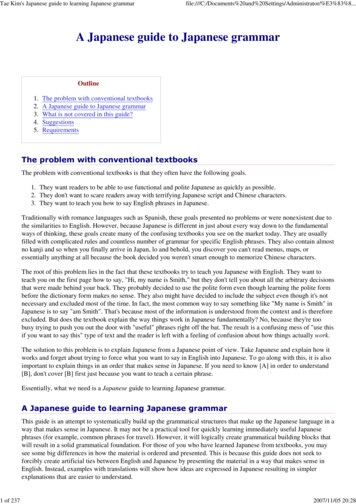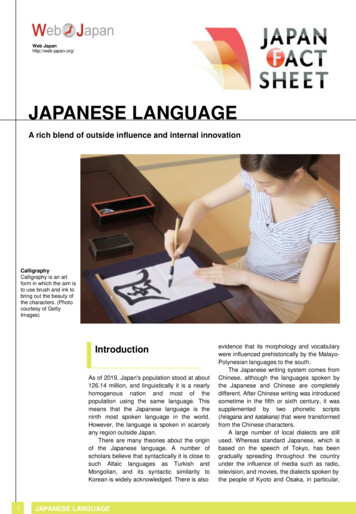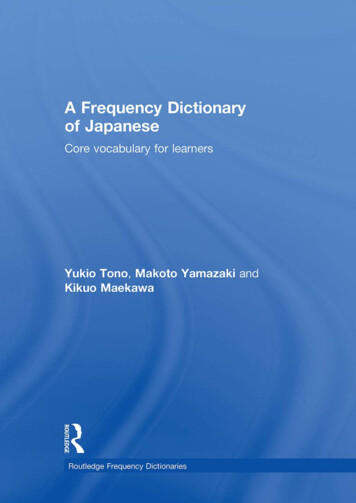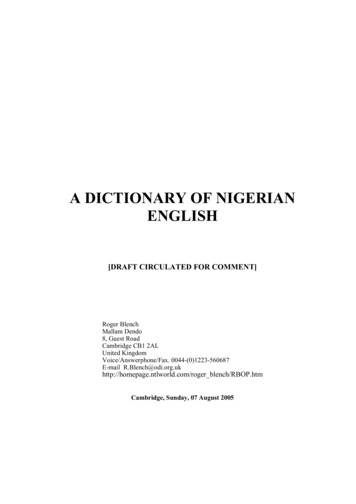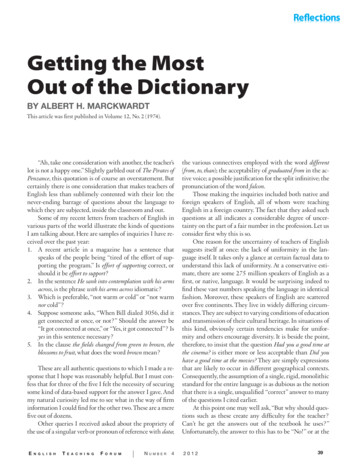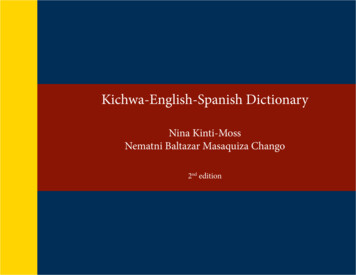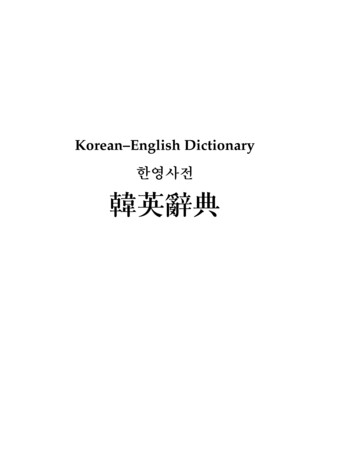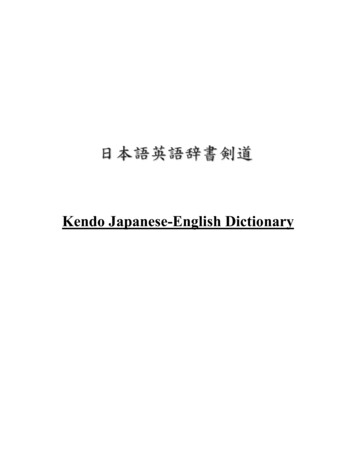
Transcription
Kendo Japanese-English Dictionary
AAgari (n.) Apprehension or nervousness; ie before a first competitionexperience or prior to a particularly important tournament cause a loss inmental and physical balance.Ai-chūdan (n.) 1. When two competitors take Chūdan position in a match,practice or Kata. 2. Beginning a match or restart of play from this position.Ai-gedan (n.) When two competitors take Gedan position in a match,practice or Kata.Ai-jōdan (n.) When two competitors take Jōdan position in a match,practice or Kata.Ai-ki (n.) A position or attitude complimentary to that of one’s opponent.(It is necessary in a military confrontation to maintain an opposite andreciprocal attitude to that of one’s opponent until the final blow of thecontest, ie when an opponent is strong, one should remain weak; when anopponent is weak one should attack vigorously. This principle is expressedin Japanese as Aikiohazusu. Through the practice of developing one’s Ki, ahigher level of Ki emerges. When resisting Ki is sublimated intoharmonizing Ki, which weakens and nullifies an enemy, it is also calledAiki.)Ai-satsu (n.) Greetings and conversational etiquette; including expressionsof congratulations, thanks and fellowship. (Polite etiquette and properrespect for fellow Kendōists is an important aspect of Kendō) See Rei.Ai-tai-suru (v.) To face each other.Ai-te (n.) An opponent in competition, practice or Kata. / Also Shiaiaite(competition opponent), Keikoaite (practice opponent).Ai-uchi (n.) 1. The exchange of simultaneous cuts of thrusts which woulddeserve a score of Ippon in a match or practice if independently delivered;ie one player strikes Men while the other simultaneously strikes Dō. / In amatch Aiuchi is not counted as YūkōDatotsu. 2. A case in which bothstrike simultaneously, ie Men and Men, but both fail to land a blow is alsoconsidered Aiuchi.
Amasu (v.) To anticipate and retreat from the attack of an opponent whiledrawing them into a vulnerable position. (The retreat should be made in agraceful manner by leaving a margin of space into which you invite anopponent's attack. This is not an exaggerated motion.)Ashi-gamae (n.) A stance from which appropriate response to anopponent's action can be made.Ashi-haba (n.) The width and length of one's stance.Ashi-hakobi (n.) See Ashisabaki.Ashi-sabaki (n.) Four types of footwork for delivering a strike or evadingan attack: Ayumiashi, Okuriashi, Hirakiashi, and Tsugiashi.Ataru (v.) To be on target; to have hit directly. / Ateru, the transitive formof Ataru.A-un-no-kokyu (n.) 1. A complimentary rhythm of respiration betweentwo competitors. 2. The careful control of movements and timing duringKata performance. / Pronunciation of the vowels "A" and "Un" representthe process of inspiration and expiration. / In Sanskrit, the vowel "A" isthe first vowel voiced with the mouth open, and "Un" is the last vowelvoiced with the mouth closed; together symbolizing a universal beginningand end.Ayumi-ashi (n.) A style of footwork developed in Kendō using alternategliding steps to cover large distances quickly.BBattō (n.) 1. Sword drawing. 2. In the practice of Kata, after completingthe standing bow and having taken three steps closer to one's opponent, theaction of drawing the sword. 3. Drawing the Shinai in practice orcompetition.Bō-gyo (n.) 1. An evasion from attack. (An attack may be evaded byblocking with the Shinai, body movement or footwork.) 2. The action ofdiscouraging an opponent from attacking though intimidation.Bokken (n.) See Bokutō.
Bokutō (n.) A sword made of Oak or Medlar wood. / Also Bokken orKidachi.Bu (n.) 1. The original meaning of the Chinese character Bu is 'Marchingwith armor in hand", or "charging ahead". 2. Referring to the military arts.(During the Edo Period, under the strong influence of ChineseConfucianism, the meaning of Bu was derived from China's oldestdictionary as "stopping the sword", and was therefore regarded as a symbolof pacifism with which to govern the world.)Bu-dō (n.) 1. The doctrine of the Japanese military class. 2. Budō alsorefers to the military code, Bushidō, and the military arts, Bujutsu. (Fromthe end of the Meiji Period through the Taisho Period it was asserted thatnot only the technical but also the mental standards of the military artsshould be raised. In 1919 the Dainippon-Butokukai, the governing bodyof all Japanese military arts, adopted the terms Kendō, Judō, and Kyūdō inplace of Gekken, Jūjutsu, and Kyūjutsu respectively. At that time, therecently popular term Budō was also regarded as a comprehensive term forthese three arts.) 3. Today the term Budō includes not only Kendō, Judō,and Kyūdō but also Sūmō, Naginata, Aikidō, Karatedō, Jū-Kendō, andShōrinji-Kenpō.Budō-kan (n.) 1. A hall or building designated for the practice of militaryarts. (Military halls may be centers accommodating practice of all themilitary arts, or may be designed specifically for one of the military arts.)2. The Nippon Budōkan is often referred to simply as Budōkan.(Formerly, the term Budōjō was used in place of Budōkan.)Bu-gei (n.) 1. Military arts. (The Chinese character Gei implies mental andphysical cultivation through training techniques.) 2. The ideas of mentaland physical development inherent in the military arts.Bugei-jūhappan (n.) The 18 different recognized disciplines of Bugei.Bu-jutsu See Bugei.Bu-toku-den (n.) The hall for military arts in Heian Jingu Shrine,constructed by Dainippon-Butokukai.Butokusai (n.) A ceremony and festival for the development of the martialarts. (On May 4, 1899 (Meiji 32), Butokusai was held in Heian Jingū.
With the foundation of the All Japan Kendō Federation in 1953 (Shōwa28) the festival was revived and is now a part of the Kyōto-Taikai.)Byō-ki (n.) 1. A state of poor health. 2. In Budō, focus of concentrationon one point, interrupting the natural flow of energy and spirit. (When acompetitor loses fluidity by focusing only on winning the match, byconcentrating too hard on the choice of techniques, or by being too tense,they will be too preoccupied to respond naturally.) See Shikai.CChakin-shibori (n.) Referring to the similarity between wringing out a wetChakin (tea ceremony cloth) and the proper grip of a sword at the momenta strike or thrust has landed. (At the moment of impact the little and ringfingers should tighten around the hilt as the thumbs rotate slight and thrustforward.)Chaku-gan (n.) A focus of view. (In Kendō it is of utmost importancewhich part of the opponent one looks at. The term Metsuke is often used inplace of Chakugan. The best method is to focus on the opponent's eyeswhile keeping their entire body in view. To avoid telegraphing an intendedstrike do not look directly at the target area. One's gaze should not befocused too strongly on one particular point or one's view of the opponentwill be limited.)Chaku-sō (n.) The method of wearing a Kendō uniform and armor. (Theproper wearing of a Kendō uniform requires a great deal of practice andexperience. Often the ability of a Kendōist can be estimated by theirappearance in uniform. It is important to wear a Kendō uniform so that it isboth neat and allows freedom of motion.)Chaku-za (n.) 1. A sitting method. 2. The method of sitting into Seizafrom a standing position. / See Seiza.Chigiri (n.) a small metal used to fix the four section of a Shinai togetherat the inside of the hilt. / See Shinai Nomenclature.Chika-ma (n.) A distance relative to one's opponent shorter than thegeneral Issokuitto.
Chō-musubi (n.) A butterfly knot. (The Men and Dō should be tied in thismanner.)Chōyaku-suburi (n.) Men strikes practiced using a forward and backwardjumping step.Chūdan-no-kamae (n.) A basic position taken with the sword tip at aheight between the eyes and solar plexus. (The height of the sword tip andhands is relative to the height of one's opponent, the distance between you,and the type of sword, Bokutō or Shinai.)Chū-shin (n.) 1. The middle or center. (It is important in Kendō to attackthe opponent's centerline.) 2. The center cross of a Shiaijō.DDai-tō (n.) The longer of two Shinai.Dan-i (n.) The rank, or level of skill, above Kyu level. (In Kendō thereare ten Dani, or levels of Dan.) See Counting Terms.Dan-tai-sen (n.) 1. Team competition. 2. competition by teams of threeplayers or more. / Officially Dantaishiai. / See Kojinsen.Dantai-shiai (n.) See Dantaisen.Dan-to-kyū (n.) 1. Grade and rank; the system of hierarchy used in Kendōto indicate levels of ability. (The first martial art to adopt the Dan systemwas Kodōkan Jūdō when the first Shodan was issued in 1883 (Meiji 16).The Kyū system was used by the Tokyo Metropolitan Police in Kendōtraining, and formally adopted in 1885 (Meiji 18). The first Kendō use ofthe Dan system was a Tokyo Normal College in 1908 (Meiji 41). TheDan-Kyū system has been used in Japan since 1917 (Taisho 6) when theDainippon Butokukai adopted the system. that system, still in use today,designates then Dan levels and six Kyū levels.)Da-totsu (n.) Strikes and thrusts.Datotsu-dōsa (n.) The coordination of the arms and legs to deliver a strikeor thrust.
Datotsu-no-kikai (n.) SeeDe-bana (n.) The very moment that an intended strikes begins, whichprovides an opportunity for counter-attack.Debana-waza (n.) Counter-attack techniques delivered at the moment ofDebana. ie Debana Men, Debana Kote, Debana Tsuki. / SeeClassification of Techniques.De-gashira (n.) See Debana.Dento-bunka (n.) Traditional culture. / Rituals, customs, and intangiblecultural assets unique to Japan transcended from ancient times (includingcodes of behavior and social contact). Especially included are theater artsfrom the Edo Period such as Nō, Kabuki, Jōryui, the arts of TeaCeremony, and Flower Arrangement, etc. As legacies of the Edo PeriodKendō, Judō, Kyudō, and Nipponbushidō are also considered culturalassets.)Dō (n.) 1. Abdomen and chest protecting armor used in Kendō. 2. One ofthe targets in Kendō competition. 3. A strike to the Dō of an opponent. /See Equipment Nomenclature and Kendō Target Areas.Dō-chū-sei (n.) The necessity for a composed and serene attitude,especially during rapid physical activity. Mental composure which enablesthe evaluation of one's opponent despite being outwardly vigorous inmovement.Dō-gu-bukuro (n.) A sack or bag for Kendō equipment.Dōji-ni (adv.) Simultaneously.Dō-jō (n.) Originally the place where Guatama Buddha receivedenlightenment under a linden tree, later the shrines where Buddhists weretrained. Eventually Dōjō became the name for martial arts training halls.Dōjō-kun (n.) The obligation to, and etiquette of, martial arts training;often a set of rules posted in a Dōjō.Dō-tō (n.) Exactly the same [ability, skill, etc.].
Dō-uchi (n.) A strike to the Dō.Dō-waza (n.) Techniques for striking the Dō.EEn (n.) 1. Buddhist term for Karma. 2. In Kendō, the relationshipbetween two players during a volley of techniques.En-bu (n.) The practice, performance, or demonstration of martial arts.En-ko (n.) An arc.En-undō (n.) A technique of striking with Shinai drawing the tip in abroad arc over one's head in a smooth continuous motion.Enzan-no-metsuke (n.) Literally "watching a mountain from afar",viewing one's opponent in their entirety. / See Metsuke.FFu-dō-shin (n.) A state of mind unaffected by outside factors, yet flexibleenough to react to any changing conditions.Fukushiki-kokyū (n.) Respiration from the diaphragm [used in Kendō].Fumi-kiri-ashi (n.) The leg which provides force and stability by pushingoff the floor, in a forward strike the left leg, in retreat the right leg.Fumi-kiri-dōsa (n.) The coordination of swinging the Shinai whilepushing off from the left leg during a forward strike.Fumi-kiru (v.) Pushing off the floor with the leg to begin a jump forward.Fumi-komi (n.) A firm stamping step forward.Fumikomi-ashi (n.) Firm stepping of the right foot, with the entire sole,and forward motion of the left foot to gain forward momentum.Fumikomi-dōsa (n.) Recovery to a vertical position by bringing the leftfoot in after a rapid forward strike used in modern Kendō; accomplished
by the continuous process of footwork from the beginning of a strike inIssokuittō distance through Okuriashi.Furi-kaburu (v.) To swing the Shinai or Katana overhead.Furi-orosu (v.) To swing the Shinai downward toward the Men, Kote, orDō.Furu (v.) To swing [the Shinai.]Fusegu (v.) To defend.GGakka-shiken (n.) A written test in a Dan level examination; usually oftheoretical nature.Gakko-Kendō (n.) The general study of Kendō in schools.Gasshuku (n.) Lodging together with other Kendōists during severalconsecutive days of training, intended to develop skill as well ascamaraderie.Gedan-no-kamae (n.) A strong defensive position with the sword tiplower than the navel.Gekken-kōgyō (n.) A unique Meiji Period demonstration, by SakakibaraKenkichi, in 1873, for the progression of Kendō, imitating modern Sūmōdemonstrations. (Held periodically until 1889 (Meiji 19), Gekkenkōgyōsignificantly contributed to the revival of Kendō.)Gi-jutsu (n.) A technique.Gi-nō (n.) A skill.Go (n.) A condition or state of being late in time or space.Go-kaku (n.) To be matched or equally in ability; similar to the identicalstructure of the two horns of one bull.
Gokaku-geiko (n.) Practice between two Kendōists of equal ability orrank. (The Chinese character Kaku is used for its meaning of rank, statusor dignity.)Goku-i (n.) The essence or core; mysterious and supreme understanding orgoal in science or the martial arts attained through a culmination of efforts.Go-no-sen (n.) The instinctual mental aspect of reacting to an attack whenboth players are jockeying for advantage. / Same as Sengonosen orTainosen. / Also see Sen.Gō-rei (n.) A command or request. / Used to indicate the beginning orexecution of an exercise or technique.Go-te (n.) A condition or state of being late in relation to an opponent.Gyaku-dō (n.) 1. The left side of the Dō. 2. A strike to
dictionary as "stopping the sword", and was therefore regarded as a symbol of pacifism with which to govern the world.) Bu-dō (n.) 1. The doctrine of the Japanese military class. 2. Budō also refers to the military code, Bushidō, and the military arts, Bujutsu. (From the end of the Meiji Period through the Taisho Period it was asserted that
